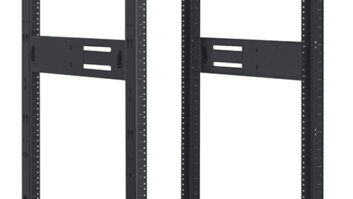
True enterprise-grade networking appliances offer the IT engineer a vast array of diagnostic tools, including the ability to record a detailed activity log. It’s hard to ignore that networking has become a major element of custom integration projects of all sizes. With a growing number of networking vendors and an immediate need to provide clients with a reliable networking solution, the term “enterprise-grade” has taken center stage in networking discussions throughout our industry, often without a clear explanation of what the term truly means. To get a better understanding, we asked Access Networks, a provider of advanced, enterprise-grade, plug-and-play networking solutions for the automated residence, to explain the term. Access Network’s VP of engineering, Brett Cantor said that there are several key products and features that separate a true enterprise-grade networking solution from its small-business and over-the-counter cousins. Here is a list of just five of the many features that every integrator should be looking for when selecting a networking solution:
1 Network Visibility
True enterprise-grade networking appliances offer the IT engineer a vast array of diagnostic tools, including the ability to record a detailed activity log. This information allows a trained IT engineer to look inside the gear and view all devices connected to the network and quickly identify an issue or problem. The result is swift issue resolution and happier clients. Without network visibility, it becomes increasingly difficult, if not impossible, to identify the root cause of an issue and solve it completely. The result is a series of network reboots, which act only as a pause button and not a problem solver.
2 Layer 3 Ethernet Switch

Part of Access Networks’ 3WN+OD wireless package, this is a Ruckus wireless outdoor access point. Three indoor 7363 access points and a wireless controller are displayed in the background.
As stated in the Open Systems Interconnections (OSI) model developed by legendary computer scientist Charles Bachman nearly a century ago, there are seven layers of communication, beginning with 1. Physical (wire), 2. Data (switching), and 3. Network (routing). A layer 3 Ethernet switch can both switch and route, providing similar functionality to a traditional router, but with increased performance.
“Using a layer 3 core switch provides wire speed inter-VLAN routing without the bottleneck of traditional ‘router-on-a-stick’ configurations,” Cantor explained. “It’s considerably faster, it scales, and it’s practically a requirement for streaming high-definition media on a large network.
While routers utilize slower, software-based packet forwarding, a layer 3 Ethernet switch employs hardware-based packet forwarding. This allows a layer 3 switch to achieve “wire-speed” routing performance, high-performance packet switching, and lower latency. With a layer 3 Ethernet switch included in your network topology, the network can then be logically segmented into multiple virtual LANs (VLANs) to prioritize traffic for latency-sensitive applications–such as voice over IP (VoIP)–divide the network into broadcast domains, and limit access to parts of the network for security. Network design that utilizes a layer 3 core switch is considered industry best practice by Cisco Systems. As your automation projects get bigger, the inclusion of a layer 3 Ethernet switch is going to become a critical element for success.
3 Wireless Controllers
A staple in the enterprise-grade market for more than seven years, the wireless controller offers integrators everywhere a path to offer their clients robust, reliable wireless access in their home or on their property.
“If you have a system with 12 access points and no wireless controller, you will have to configure each of the 12 individually,” Cantor added. “With a wireless controller, you create one configuration, and it’s pushed automatically to every access point on the network. Need to change the configuration? You do it in one place and every single access point gets updated immediately.”
Once programmed and deployed, the wireless controller centrally manages a series of access points controlling radio strength adjustments, channel settings and roaming based on real time environmental conditions. Additionally, as with all true enterprise-grade networking appliances, the wireless controller offers an array of diagnostic tools or network visibility. The resulting log allows the IT engineer to swiftly identify an issue or rule the wireless network out as variable entirely. Without this tool set, the management of issue-resolution when the wireless network is a variable becomes extremely challenging.
4 Dual-Band Access Points
Single-band access points are only as fast as the slowest client connected. In other words, if there were 50 802.11N clients connected to a given wireless network and one 802.11G client connected, the entire wireless network will slow down to 802.11G speed. A dual-band access point broadcasts both a 2.4Ghz wireless environment and a 5Ghz environment concurrently. This ensures that devices equipped with the current 5Ghz standard radio (iPhone’s, iPads, laptops, etc.) will not only take advantage of the increased speeds the 802.11N standard offers, but will also stay away from the overcrowded and interference-laden 2.4Ghz spectrum. In densely populated areas, or projects with multiple wireless clients used for automation control, this becomes a vital element of a successful and reliable deployment.
“There are too many devices on the 2.4GHz spectrum, and too few usable channels,” Cantor said. “Not only does 5GHz offer several more available channels that are used by fewer devices, it also provides faster performance for the devices connected to it.”
5 Outdoor Wi-Fi
Today’s consumer expects wireless coverage outside in their backyard to be as reliable as the coverage they experience inside their home. In many cases, a common Wi-Fi router is not going to have the range to accommodate sophisticated electronics outside of the home, especially in projects with large outdoor areas. Depending on the manufacturer, there will be one or many choices of outdoor access points. If you have already deployed dual-band access points inside, then a dual-band outdoor access point should be your choice. You want to pay careful attention to the operating conditions and tolerances that the manufacturer details. If you are already making use of a wireless controller, than the indoor to outdoor transition will be fully managed, allowing the end user to seamlessly walk from inside to out and back again without being disconnected from the wireless network.
When it comes to deploying a home network, professional integrators can no longer afford to neglect these vital features. Now, more than ever, integrators need to understand what truly determines a professional-grade network from unreliable out-of-the-box products.
Jeremy Glowacki is editorial director of Residential Systems and Systems Contractor News.







